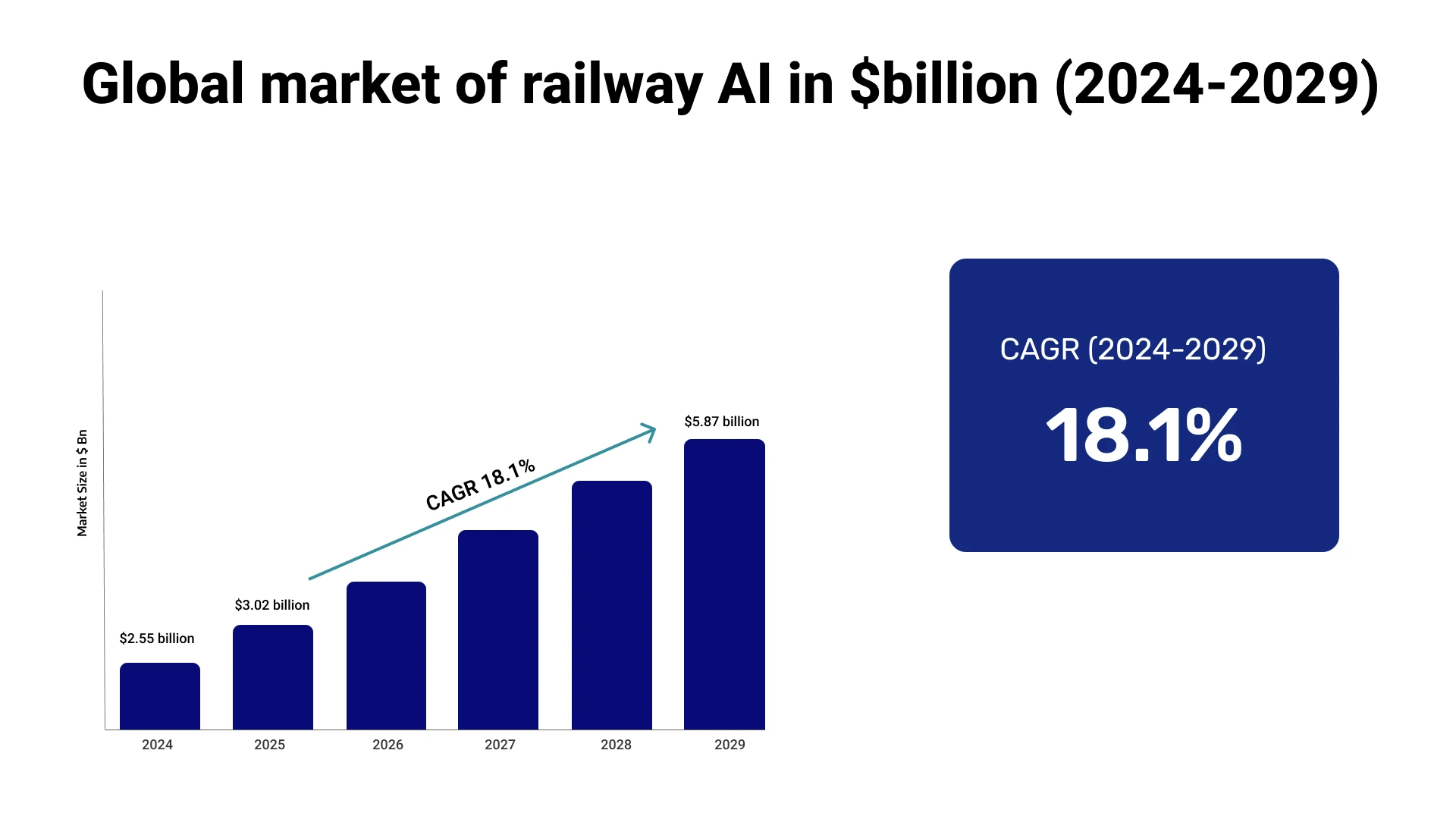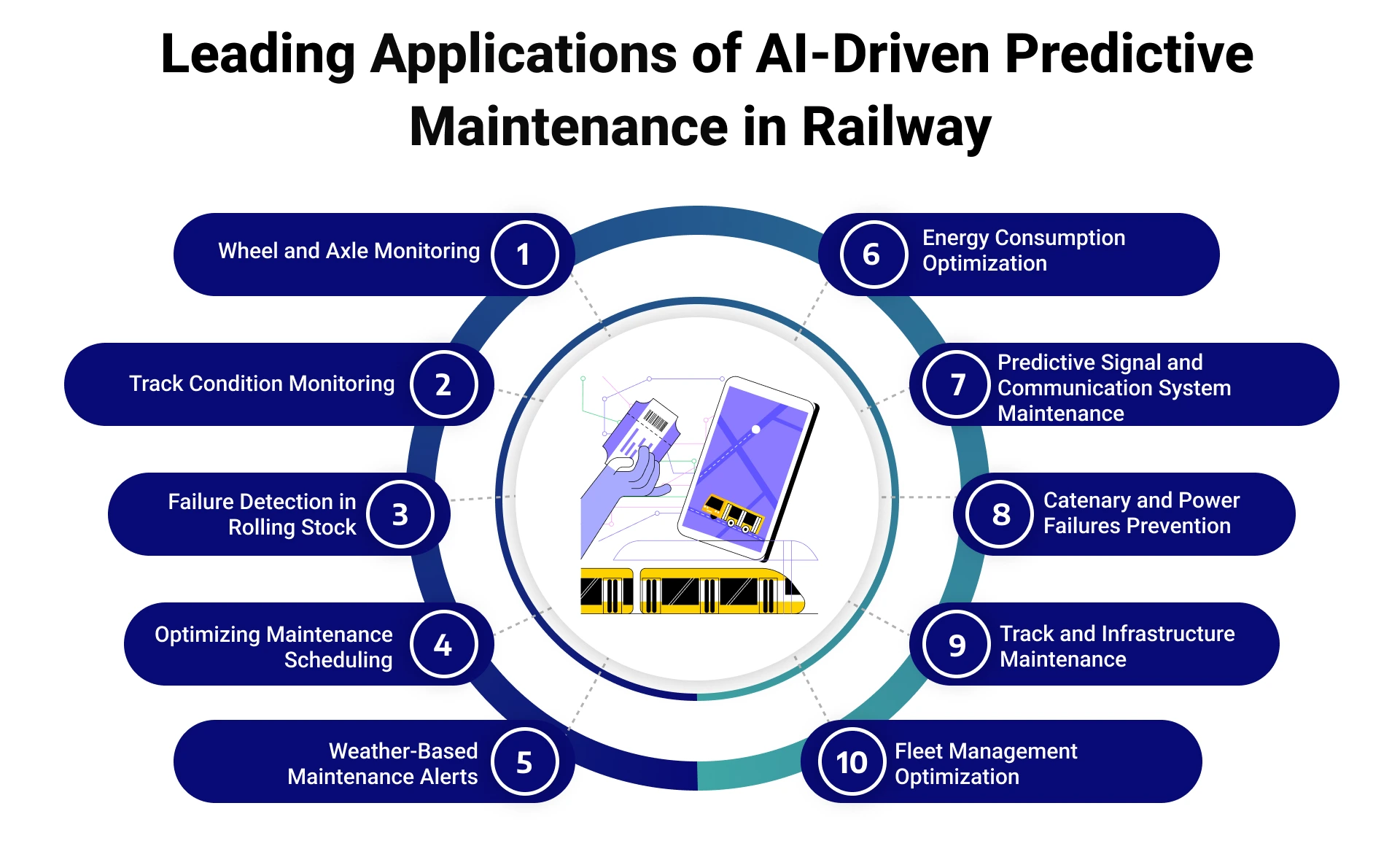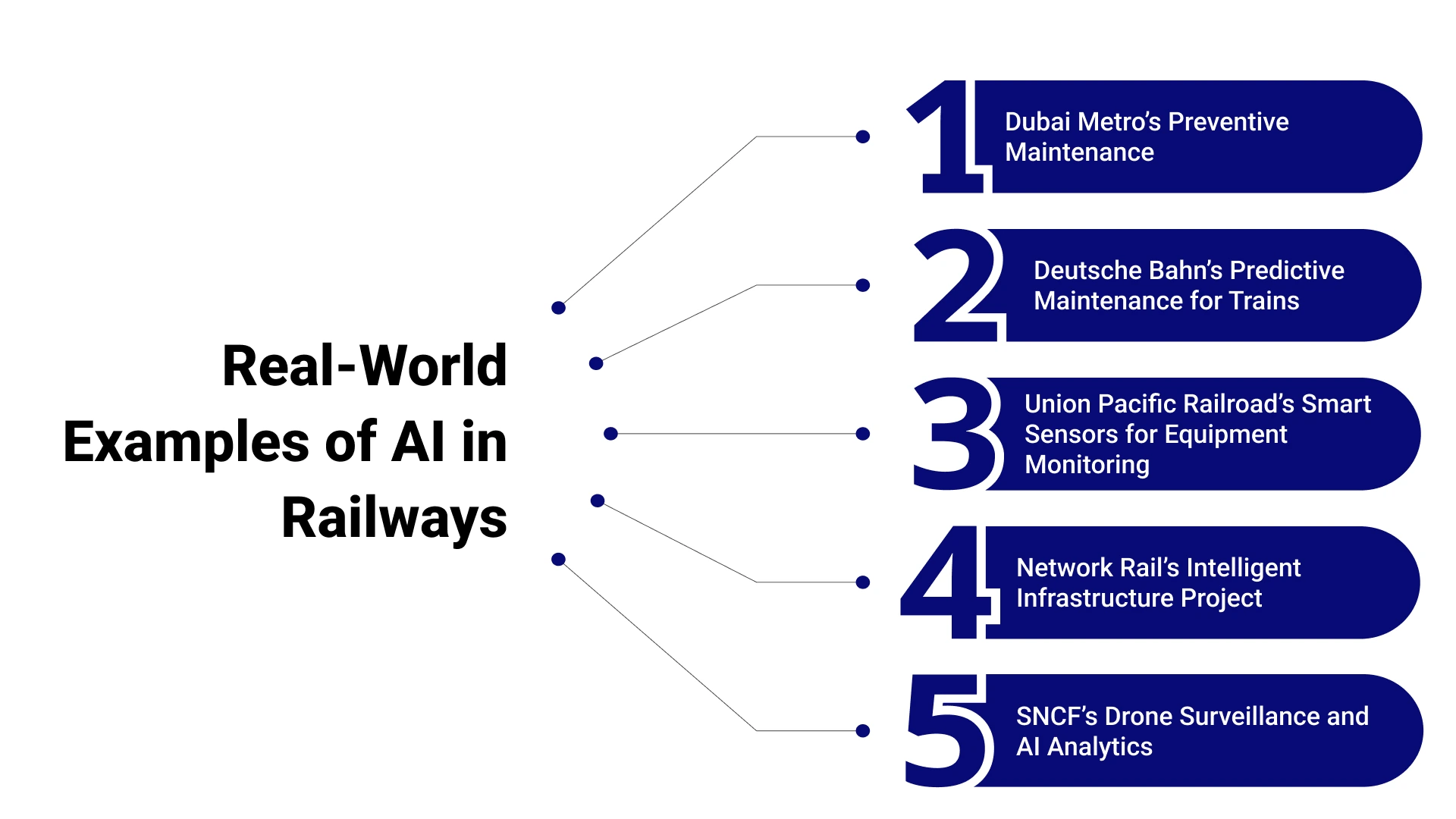No need to mention that the rapid advancements of AI technology are revolutionizing all industries, and the railway sector is no exception.
 The integration of AI-powered predictive analytics and maintenance has modernized train operations, bringing a significant improvement in the railroad industry.
The integration of AI-powered predictive analytics and maintenance has modernized train operations, bringing a significant improvement in the railroad industry.
In this article, we will explore the impact of AI in railways, with a focus on predictive analytics and maintenance, which have redefined efficiency, safety, and sustainability in the railroad industry.
Benefits of Using AI-powered Predictive Analytics in Railways
Predictive maintenance for the railroad industry brings a host of advantages, revolutionizing maintenance practices and ensuring railway performance. By leveraging AI-powered predictive analytics, railroads can proactively detect and address potential failures, optimize maintenance schedules, and improve operational efficiency.
Let's have a detailed look at some of the top benefits of using predictive maintenance in the railway sector.

Improved Reliability
AI-powered predictive maintenance has transformed the railroad industry by improving reliability, safety, and operational efficiency. By harnessing AI in railways industry, operators can now early detect potential issues, resulting in reduced accident risks and costly damages.
This proactive approach safeguards passengers and crew while optimizing maintenance schedules based on real-time equipment conditions, ensuring minimized downtime and increased asset reliability. Embracing AI-driven predictive analytics empowers the railway sector to confidently move towards a safer, more reliable, secure, and efficient future in transportation.
Reduced Costs
Integration of AI and machine learning in railways, delivers significant cost savings and enhanced efficiency.
Harnessing AI-driven predictive analytics allows operators to optimize maintenance strategies and bring various benefits to the railway industry. By forecasting potential issues in important components, including locomotives and track infrastructure, railway operators can reduce downtime and service disruptions. It results in lower operational costs and enhanced service reliability.
Optimized maintenance schedules based on real-time data ensure efficient resource allocation and minimize unwanted maintenance expenses, leading to substantial long-term cost savings.
Longer Lifespan of Equipment
Another important benefit of implementing AI in railways is extended equipment durability. AI-enabled predictive analytics increase the lifespan of railway assets by proactively addressing maintenance needs. Predictive maintenance reduces excessive wear and tear on rolling stock and infrastructure, ensuring higher performance over time.
Leveraging AI and machine learning in railways extends the usability of valuable assets, prevents costly replacements, and achieves higher ROI. This ultimately leads to enhanced lifespan and sustainability of railway operations.
Strong Competitive Advantage
Predictive maintenance, driven by AI in railways, provides strong competitive advantages by offering superior reliability, safety, and efficiency. By leveraging artificial intelligence for smart maintenance in railroads, tech-savvy travelers, stakeholders, and investors can benefit from a modern, efficient, and sustainable transportation solution.
This technological advancement ensures cost savings, optimized resource management, and long-term sustainability, making railways a smarter investment.
Adopting AI-driven predictive maintenance propels railways into a new era, providing a competitive advantage that drives success in the ever-evolving transportation industry.
Scalable and Future-Ready Solutions
Another benefit of using AI in railways is unparalleled scalability and future-proofing capabilities. Embracing AI-enabled predictive maintenance allows rail operators to adapt to rapidly changing technology advancements seamlessly.
The flexibility of AI automation in railways facilitates the seamless expansion of rail networks. Intelligent algorithms can efficiently handle data from an increasing number of sensors and devices, ensuring a smooth transition to complex networks.
Predictive maintenance is a future-proof investment crucial for ensuring sustainable and efficient railway operations.
Data-Driven Decision Making
The integration of generative AI in railways has transformed decision-making, ensuring predictive maintenance in railroads, a game-changer for the transportation industry. With AI-driven predictive analytics, rail operators can utilize real-time data for data-driven decision-making.
For instance, advanced AI/ML models identify huge amounts of sensor data from trains, tracks, and other infrastructure to forecast maintenance requirements accurately. This early detection of potential faults allows operators to schedule proactive maintenance, ensuring enhanced asset performance and minimized unexpected disruptions.
Adopting data-driven predictive maintenance is modernizing the railway sector, ensuring a more efficient and reliable transportation network for passengers and freight.
Enhanced Asset Performance
Artificial Intelligence plays a vital role in optimizing asset performance in the railway industry by ensuring all elements of railway equipment operate at higher efficiency. With AI-powered predictive analytics, ongoing monitoring of locomotives, tracks, and signaling systems enables early detection of performance issues.
This proactive approach minimizes downtime, maximizes equipment utilization, and reduces energy consumption. By preventing failures and identifying inefficiencies, AI-powered predictive maintenance contributes to smoother operations, increased service reliability, extended equipment lifespan, and lower operational costs.
Ultimately, this leads to enhanced overall efficiency and profitability for railway operations.
Mitigated Safety Risks
With AI in railways powering predictive maintenance, the railways gain improved safety and risk prevention. AI-driven predictive analytics enhances safety by identifying and mitigating potential hazards such as worn-out components or abnormal operating conditions.
Improved risk management also ensures compliance with safety regulations and standards. Ultimately, predictive maintenance helps mitigate safety risks and ensure a safer working environment for passengers, employees, and cargo, fostering trust in railway services.
Predictive Maintenance Use Cases for the Railroad Industry
Artificial intelligence is transforming the transportation industry, especially in the railway. From fault detection to optimized maintenance schedules, the diverse applications of predictive maintenance with AI in railways explain the exponential surge of this industry.
Let's discover the top 10 use cases of predictive maintenance with AI in the railways, exploring how technology is a driving force in revolutionizing the sector.

Wheel and Axle Monitoring
AI in railways plays a vital role in modernizing wheel and axle condition monitoring, offering numerous benefits to the railway sector. AI-enabled predictive analytics can forecast potential failures, reducing derailment risks and maintenance costs.
With this real-time data, operators can timely repair or replace rail components, ensuring smoother operations and enhanced safety.
This proactive approach minimizes unscheduled downtimes, increases the durability of elements, and optimizes resource allocation, contributing to overall operational efficiency and cost savings.
Track Condition Monitoring
Track condition monitoring is another example of AI in railways use cases. The implementation of ML in railway sector enables revolutionary track conditions monitoring and defect identification, such as cracks, misalignments, and loose fastenings.
By predicting deterioration trends and prioritizing maintenance tasks, the AI-powered predictive maintenance approach prevents accidents, detects equipment malfunctions, reduces repair costs, and improves train punctuality.
Continuous automated monitoring systems eliminate the need for manual inspections, enhancing safety and operational efficiency while increasing the lifespan of the entire railroad infrastructure.
Failure Detection in Rolling Stock
The implementation of AI in railways enables a groundbreaking capability to detect faults in rolling stock and its components, such as brakes, engines, and HVAC systems. By identifying failure patterns, predictive maintenance enables preemptive repairs and reduces the risk of operational breakdowns.
This proactive approach improves passengers' safety, minimizes repair expenses, and reduces service disruptions. Through regular monitoring of locomotives and carriages, asset lifespan is extended, and rolling stock operates optimally, ensuring more reliable train services.
Optimizing Maintenance Scheduling
Leveraging AI in railways delivers transformative advantages by optimizing maintenance schedules. By analyzing data patterns, environmental factors, and equipment performance data, AI and machine learning in railways streamline maintenance schedules and reduce unnecessary downtime and operational expenses.
AI-powered predictive scheduling improves asset utilization, extends equipment lifespan, and increases train availability. Automated maintenance planning enhances workforce efficiency and ensures compliance with safety regulations, ultimately leading to more reliable railway operations.
Weather-Based Maintenance Alerts
Embracing the power of artificial intelligence in railways, predictive maintenance offers weather-based maintenance alerts. With the power of AI/ML models, train operators can analyze to forecast how adverse conditions, including heatwaves, heavy rains, or snowstorms, affect rail infrastructure.
AI algorithms predict worse weather conditions, like heavy rain or extreme heat, might impact the tracks and other components of rails. These algorithms then alert maintenance crews to conduct timely inspections and repairs, preventing potential safety hazards and service disruption.
Additionally, weather-driven insights support resource optimization and more efficient maintenance planning, ultimately boosting service reliability.
Energy Consumption Optimization
Harnessing the power of AI in railways industry enables the analysis of energy usage patterns across trains and infrastructure to optimize energy consumption. AI-enabled predictive maintenance analyzes inefficiencies and recommends corrective measures, such as adjusting train speeds or optimizing engine performance.
For instance, Autonomous trains, powered by artificial intelligence and machine learning, dynamically adjust speed and power consumption based on real-time data. Predictive maintenance enhances energy efficiency without compromising travel time or safety, leading to reduced operational costs and a minimized environmental impact.
Energy optimization also supports sustainability initiatives by reducing the environmental impact of railway operations, contributing to sustainable and cost-effective transportation solutions.
Predictive Signal and Communication System Maintenance
One of the major use cases of AI in railways is predictive signal and communication systems, revolutionizing safety and reliability in train operations.
For instance, AI/ML algorithms can identify real-time data from communication networks and signaling systems to detect anomalies or patterns indicating potential failures. Then, these algorithms alert the maintenance team in advance to address and rectify these issues, preventing disruptions and ensuring seamless train services.
By using AI in railways signaling and train traffic management, operators can effectively monitor signal and communication systems to detect faults before they impact operations. Predictive analytics enable timely and well-planned maintenance schedules, preventing signal failures and ensuring smooth communication between control centers and trains.
Catenary and Power Failures Prevention
AI-driven predictive maintenance is transforming the railroad industry by preventing catenary and power failures. AI in railways maintenance enhances operational efficiency and ensures uninterrupted train services.
With the use of AI in railways, predictive analytics can monitor the overhead catenary systems and power supply infrastructure for early signs of wear or malfunction. Machine learning models analyze voltage fluctuations, temperature variations, and mechanical stress in real time to identify potential issues before they escalate.
As a result, maintenance teams can proactively schedule repairs, preventing unexpected outages and minimizing downtime.
Track and Infrastructure Maintenance
Another significant application of AI in railways maintenance is improving track and infrastructure maintenance. Leveraging ML in railways, AI systems can analyze data collected from track sensors, vibration monitors, and ground-penetrating radar to detect structural weaknesses or track misalignments.
This enables maintenance crews to prioritize high-risk areas and implement timely repairs, enhancing passenger safety. Predictive analytics optimize maintenance cycles, ensuring consistent track performance and extending infrastructure lifespan.
Fleet Management Optimization
Optimizing fleet management is also a vital use case of AI in railways, where predictive maintenance plays a crucial role in enhancing asset utilization and reducing operational costs.
AI-driven predictive maintenance in railway processes data from onboard sensors, engine diagnostics, and maintenance logs to predict potential failures in locomotives and railcars. This proactive approach allows operators to plan maintenance activities without disrupting schedules, improving fleet reliability and reducing repair costs.
AI-powered train streamlines asset management, ensuring maximum efficiency and longevity of rolling stock.
Case Studies: AI Success Stories in Railways
The future of AI-powered trains can be best analyzed by looking into the companies that are working in that direction. While the use cases of AI in railways are in line with the use cases and benefits, we explored above, worldwide railway networks are increasingly adopting artificial intelligence solutions that prioritize unmatched efficiency, high traveler satisfaction, and guaranteed rail safety.
Let’s have a look at some popular real-world examples of AI in railways.

Dubai Metro’s Preventive Maintenance
The Dubai Metro's adoption of AI-driven maintenance has significantly reduced service disruptions. By proactively detecting maintenance requirements, the metro system keeps trains operating seamlessly, improving the daily commute for thousands of passengers.
Deutsche Bahn’s Predictive Maintenance for Trains
Deutsche Bahn employs predictive analytics through its "Predictive Maintenance Platform" to monitor components like brakes, wheels, and doors. AI-driven predictive maintenance reduces downtime and ensures smoother operations.
Union Pacific Railroad’s Smart Sensors for Equipment Monitoring
Union Pacific uses smart sensors and AI to monitor locomotive engines and track infrastructure. Predictive analytics detect anomalies in wheel bearings and other critical parts, preventing derailments and equipment failures.
Network Rail’s Intelligent Infrastructure Project
Network Rail integrates AI with IoT sensors to predict faults in railway assets, including tracks, signals, and overhead lines. This system identifies early signs of wear and tear, enabling timely maintenance and reducing service disruptions.
SNCF’s Drone Surveillance and AI Analytics
SNCF uses drones equipped with AI-powered cameras and advanced AI in surveillance system to inspect tracks, bridges, and tunnels. Predictive analytics processes visual data to detect structural issues, allowing for preventive repairs and enhancing passenger safety.
Cost-Benefit Analysis: ROI of AI in Railway Maintenance
Despite initial implementation costs, AI adoption in railway maintenance delivers a strong return on investment (ROI). Predictive maintenance powered by AI helps reduce unexpected failures and service disruptions, leading to cost savings on emergency repairs and increased train availability.
For example, AI-driven real-time monitoring can detect early signs of wear and tear on tracks and rolling stock, allowing for proactive interventions that extend asset lifespan. Studies suggest that predictive maintenance can cut maintenance costs by 20-30% and reduce downtime by 30-50%.
Additionally, AI-powered energy optimization helps railways reduce fuel consumption and carbon emissions, further contributing to cost savings. The improved operational efficiency and enhanced passenger experience ultimately lead to increased revenue.
Ethical and Regulatory Challenges in AI Adoption in Railways
The integration of AI in railways brings significant benefits, but it also raises ethical and regulatory concerns.
Data privacy is a major challenge, as AI-driven predictive maintenance relies on vast amounts of sensor data from trains, tracks, and passengers. Ensuring compliance with data protection regulations such as GDPR or CCPA is essential to prevent unauthorized access and misuse of sensitive information.
Another critical issue is the impact on the workforce. AI and automation may replace certain jobs, particularly in manual inspection and routine maintenance. While AI can enhance efficiency, railway companies must invest in reskilling programs to ensure employees adapt to new roles, such as AI system monitoring and data analysis.
Additionally, AI bias can pose risks in predictive maintenance models. If AI systems are trained on incomplete or biased datasets, they may generate inaccurate maintenance predictions, potentially leading to safety hazards or operational inefficiencies.
To mitigate this, railway operators must ensure diverse and high-quality data sources and implement continuous model auditing.
Regional Focus: AI Adoption in Underrepresented Markets
While AI adoption in railways is advancing in developed regions, underrepresented markets like Africa and Southeast Asia present unique opportunities and challenges. These regions are experiencing rapid urbanization and increasing demand for efficient rail networks, making AI-powered predictive maintenance crucial for infrastructure longevity.
However, challenges such as limited digital infrastructure, high initial investment costs, and regulatory barriers slow AI adoption. Many rail networks in these regions still rely on traditional maintenance approaches, leading to inefficiencies and higher operational costs.
To accelerate AI integration, governments and railway operators in these regions can leverage public-private partnerships (PPPs) and international investments. Funding initiatives from global organizations, along with knowledge-sharing collaborations, can help bridge the technology gap. Additionally, adopting cost-effective AI solutions tailored to regional needs—such as cloud-based predictive maintenance systems—can facilitate gradual and scalable implementation.
By overcoming these challenges, AI can play a pivotal role in modernizing rail networks in emerging markets, improving safety, reducing maintenance costs, and ensuring long-term sustainability.
AI Emerging Tools for Railways
Here are emerging tools of AI for railways:
- Digital Twins – Creates virtual replicas of railway systems for real-time monitoring, predictive maintenance, and performance optimization.
- AI-Powered Drones – Conduct automated rail inspections, detect track defects, and enhance safety with high-precision monitoring.
- Predictive Maintenance Systems – Analyze sensor data to predict equipment failures, reducing downtime and improving efficiency.
- AI-Based Traffic Management – Optimizes train scheduling and routing to minimize congestion and delays.
Computer Vision for Safety Monitoring – Uses AI-powered cameras to detect obstacles, track defects, and unauthorized access in real time.
Revolutionize Railway Operations with AI-Powered Solutions by VLink!
By partnering with a trusted AI development company like VLink, you gain access to advanced predictive analytics applications that drive proactive maintenance, minimizing costly downtime and disruptions in train services. Our AI-driven solutions allow you to analyze the performance data of your entire fleet, ensuring optimal utilization of rolling stock while extending its longevity, ultimately leading to significant cost savings.
Embrace the future of railways with our reliable AI solutions and transform your network into a highly efficient, reliable, and future-ready transportation system. Connect with our experts today!









 Shivisha Patel
Shivisha Patel
















